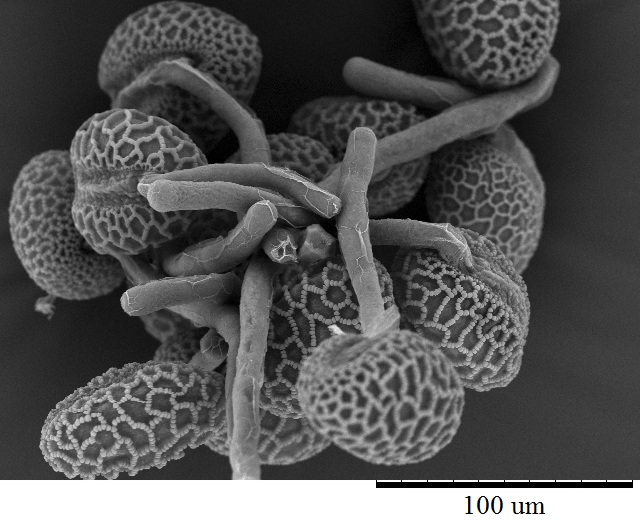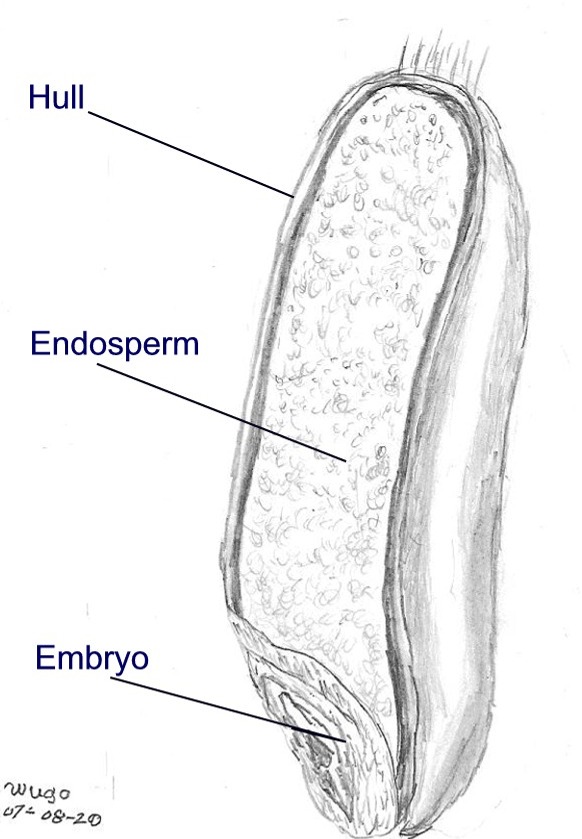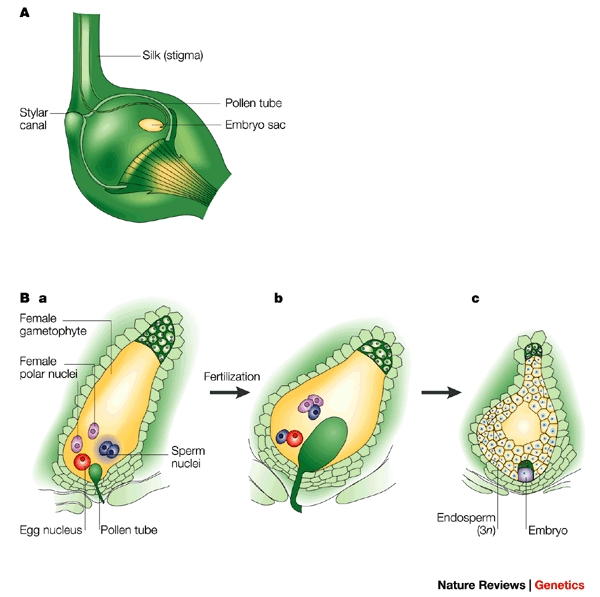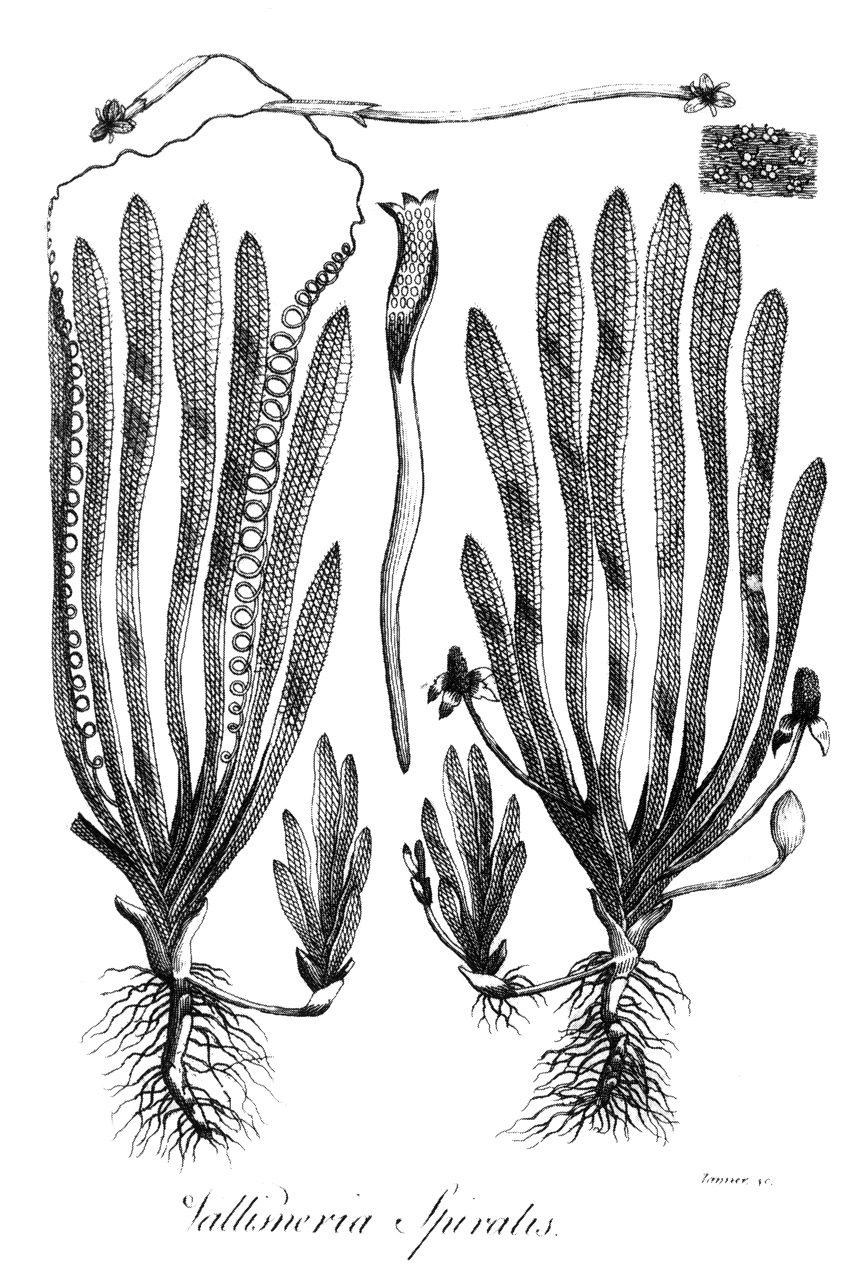|
Pollen Tube
A pollen tube is a tubular structure produced by the male gametophyte of seed plants when it germinates. Pollen tube elongation is an integral stage in the plant life cycle. The pollen tube acts as a conduit to transport the male gamete cells from the pollen grain—either from the stigma (in flowering plants) to the ovules at the base of the pistil or directly through ovule tissue in some gymnosperms. In maize, this single cell can grow longer than to traverse the length of the pistil. Pollen tubes were first discovered by Giovanni Battista Amici in the 19th century. They are used as a model for understanding plant cell behavior. Research is ongoing to comprehend how the pollen tube responds to extracellular guidance signals to achieve fertilization. Pollen tubes are unique to seed plants and their structures have evolved over their history since the Carboniferous period. Pollen tube formation is complex and the mechanism is not fully understood. Angiosperms The male ... [...More Info...] [...Related Items...] OR: [Wikipedia] [Google] [Baidu] |
Vegetative Cell
In cellular biology, a somatic cell (), or vegetal cell, is any biological cell forming the body of a multicellular organism other than a gamete, germ cell, gametocyte or undifferentiated stem cell. Somatic cells compose the body of an organism and divide through mitosis. In contrast, gametes derive from meiosis within the germ cells of the germline and they fuse during sexual reproduction. Stem cells also can divide through mitosis, but are different from somatic in that they differentiate into diverse specialized cell types. In mammals, somatic cells make up all the internal organs, skin, bones, blood and connective tissue, while mammalian germ cells give rise to spermatozoa and ova which fuse during fertilization to produce a cell called a zygote, which divides and differentiates into the cells of an embryo. There are approximately 220 types of somatic cell in the human body. Theoretically, these cells are not germ cells (the source of gametes); they transmit their mutations ... [...More Info...] [...Related Items...] OR: [Wikipedia] [Google] [Baidu] |
Style (botany)
In botany, the style of an angiosperm flower is an organ of variable length that connects the ovary to the stigma. The style does not contain ovules; these are limited to the region of the gynoecium (female organs of the flower) called the "ovary". Structure The style is a narrow extension of the ovary, usually pointing upwards, connecting the ovary to the stigmatic papillae. It may be absent in some plants; in this case, it is referred to as a sessile stigma. Styles generally resemble more or less long tubes. The style can be open (with few cells occupying the central part, or even none), featuring a central canal that may be filled with mucilage. Alternatively, the style can be closed (completely filled with cells). Most plants with syncarpous pistils ( monocotyledons and some eudicotys) have open styles, whereas many eudicots and grasses have closed (solid) styles containing specialized secretory tissues, which connect the stigma to the center of the ovary. These tissu ... [...More Info...] [...Related Items...] OR: [Wikipedia] [Google] [Baidu] |
Endosperm
The endosperm is a tissue produced inside the seeds of most of the flowering plants following double fertilization. It is triploid (meaning three chromosome sets per nucleus) in most species, which may be auxin-driven. It surrounds the Embryo#Plant embryos, embryo and provides nutrition in the form of starch, though it can also contain Vegetable oil, oils and protein. This can make endosperm a source of nutrition in animal diet. For example, wheat endosperm is ground into flour for bread (the rest of the grain is included as well in whole wheat flour), while barley endosperm is the main source of sugars for beer production. Other examples of endosperm that forms the bulk of the edible portion are coconut "meat" and coconut "water", and Maize, corn. Some plants, such as certain orchids, lack endosperm in their seeds. Ancestral flowering plants have seeds with small embryos and abundant endosperm. In some modern flowering plants the embryo occupies most of the seed and the endosperm ... [...More Info...] [...Related Items...] OR: [Wikipedia] [Google] [Baidu] |
Zygote
A zygote (; , ) is a eukaryote, eukaryotic cell (biology), cell formed by a fertilization event between two gametes. The zygote's genome is a combination of the DNA in each gamete, and contains all of the genetic information of a new individual organism. The sexual fusion of haploid cells is called karyogamy, the result of which is the formation of a Ploidy#Haploid and monoploid, diploid cell called the zygote or zygospore. History German zoologists Oscar Hertwig, Oscar and Richard Hertwig made some of the first discoveries on animal zygote formation in the late 19th century. In multicellular organisms The zygote is the earliest developmental stage. In humans and most other Anisogamy, anisogamous organisms, a zygote is formed when an egg cell and sperm, sperm cell come together to create a new unique organism. The formation of a cell potency, totipotent zygote with the potential to produce a whole organism depends on epigenetics, epigenetic reprogramming. DNA demethyla ... [...More Info...] [...Related Items...] OR: [Wikipedia] [Google] [Baidu] |
Double Fertilization
Double fertilization or double fertilisation (see spelling differences) is a complex fertilization mechanism of angiosperms. This process involves the fusion of a female gametophyte or megagametophyte, also called the embryonic sac, with two male gametes (sperm). It begins when a pollen grain adheres to the stigmatic surface of the carpel, the female reproductive structure of angiosperm flowers. The pollen grain begins to germinate (unless a type of self-incompatibility that acts in the stigma occurs in that particular species and is activated), forming a pollen tube that penetrates and extends down through the style toward the ovary as it follows chemical signals released by the egg. The tip of the pollen tube then enters the ovary by penetrating through the micropyle opening in the ovule, and releases two sperm into the embryonic sac (megagametophyte). The mature embryonic sac of an unfertilized ovule is 7-cellular and 8-nucleate. It is arranged in the form of 3+1+3 (from ... [...More Info...] [...Related Items...] OR: [Wikipedia] [Google] [Baidu] |
Gamete
A gamete ( ) is a Ploidy#Haploid and monoploid, haploid cell that fuses with another haploid cell during fertilization in organisms that Sexual reproduction, reproduce sexually. Gametes are an organism's reproductive cells, also referred to as sex cells. The name gamete was introduced by the German cytologist Eduard Strasburger in 1878. Gametes of both mating individuals can be the same size and shape, a condition known as isogamy. By contrast, in the majority of species, the gametes are of different sizes, a condition known as anisogamy or heterogamy that applies to humans and other mammals. The human ovum has approximately 100,000 times the volume of a single human sperm cell. The type of gamete an organism produces determines its sex and sets the basis for the sexual roles and sexual selection. In humans and other species that produce two Morphology (biology), morphologically distinct types of gametes, and in which Gonochorism, each individual produces only one type, a femal ... [...More Info...] [...Related Items...] OR: [Wikipedia] [Google] [Baidu] |
Cytoplasm
The cytoplasm describes all the material within a eukaryotic or prokaryotic cell, enclosed by the cell membrane, including the organelles and excluding the nucleus in eukaryotic cells. The material inside the nucleus of a eukaryotic cell and contained within the nuclear membrane is termed the nucleoplasm. The main components of the cytoplasm are the cytosol (a gel-like substance), the cell's internal sub-structures, and various cytoplasmic inclusions. In eukaryotes the cytoplasm also includes the nucleus, and other membrane-bound organelles.The cytoplasm is about 80% water and is usually colorless. The submicroscopic ground cell substance, or cytoplasmic matrix, that remains after the exclusion of the cell organelles and particles is groundplasm. It is the hyaloplasm of light microscopy, a highly complex, polyphasic system in which all resolvable cytoplasmic elements are suspended, including the larger organelles such as the ribosomes, mitochondria, plant plasti ... [...More Info...] [...Related Items...] OR: [Wikipedia] [Google] [Baidu] |
Self-sterile
Self-incompatibility (SI) is a general name for several genetic mechanisms that prevent self-fertilization in sexually reproducing organisms, and thus encourage outcrossing and allogamy. It is contrasted with separation of sexes among individuals (dioecy), and their various modes of spatial ( herkogamy) and temporal (dichogamy) separation. SI is best-studied and particularly common in flowering plants, although it is present in other groups, including sea squirts and fungi. In plants with SI, when a pollen grain produced in a plant reaches a stigma of the same plant or another plant with a matching allele or genotype, the process of pollen germination, pollen-tube growth, ovule fertilization, or embryo development is inhibited, and consequently no seeds are produced. SI is one of the most important means of preventing inbreeding and promoting the generation of new genotypes in plants and it is considered one of the causes of the spread and success of angiosperms on Earth. Mechan ... [...More Info...] [...Related Items...] OR: [Wikipedia] [Google] [Baidu] |
Lipid
Lipids are a broad group of organic compounds which include fats, waxes, sterols, fat-soluble vitamins (such as vitamins A, D, E and K), monoglycerides, diglycerides, phospholipids, and others. The functions of lipids include storing energy, signaling, and acting as structural components of cell membranes. Lipids have applications in the cosmetic and food industries, and in nanotechnology. Lipids are broadly defined as hydrophobic or amphiphilic small molecules; the amphiphilic nature of some lipids allows them to form structures such as vesicles, multilamellar/ unilamellar liposomes, or membranes in an aqueous environment. Biological lipids originate entirely or in part from two distinct types of biochemical subunits or "building-blocks": ketoacyl and isoprene groups. Using this approach, lipids may be divided into eight categories: fatty acyls, glycerolipids, glycerophospholipids, sphingolipids, saccharolipids, and polyketides (derived from condensatio ... [...More Info...] [...Related Items...] OR: [Wikipedia] [Google] [Baidu] |
Zoophily
Zoophily, or zoogamy, is a form of pollination whereby pollen is transferred by animals, usually by invertebrates but in some cases vertebrates, particularly birds and bats, but also by other animals. Zoophilous species frequently have evolved mechanisms to make themselves more appealing to the particular type of pollinator, e.g. brightly colored or scented flowers, nectar, and appealing shapes and patterns. These plant-animal relationships are often mutually beneficial because of the food source provided in exchange for pollination. Pollination is defined as the transfer of pollen from the anther to the stigma. There are many vectors for pollination, including abiotic (wind and water) and biotic (animal). There are benefits and costs associated with any vector. For instance, using animal pollination is beneficial because the process is more directed and often results in pollination. At the same time it is costly for the plant to produce rewards, such as nectar, to attract anim ... [...More Info...] [...Related Items...] OR: [Wikipedia] [Google] [Baidu] |
Water Pollination
Hydrophily is a fairly uncommon form of pollination whereby pollen is distributed by the flow of waters, particularly in rivers and streams. Hydrophilous species fall into two categories: (i) Those that distribute their pollen to the surface of water. e.g. ''Vallisnerias male flower or pollen grain are released on the surface of water, which are passively carried away by water currents; some of them eventually reach the female flower (ii) Those that distribute it beneath the surface. e.g. seagrasses in which female flower remain submerged in water and pollen grains are released inside the water. Surface pollination Surface pollination is more frequent, and appears to be a transitional phase between wind pollination and true hydrophily. In these the pollen floats on the surface and reaches the stigmas of the female flowers as in ''Hydrilla'', '' Callitriche'', ''Ruppia'', ''Zostera'', ''Elodea''. In ''Vallisneria'' the male flowers become detached and float on the surface of the w ... [...More Info...] [...Related Items...] OR: [Wikipedia] [Google] [Baidu] |





